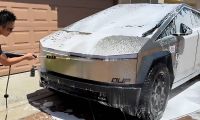As I described in my previous article, I have finally taken my first longer trip in my Sorento plug-in hybrid. My outbound results were excellent, but the return home was even better. I was able to get 45.2 mpg on the final leg of my trip (which was approximately 60 miles, see photo above). Note that I stopped roughly midway through the return leg, and technically I got 38.9 mpg for the first 47 miles of of the return trip which was mostly on 70mph freeway (see below).

And, for those that may wonder, after over 700 miles of driving my Sorento PHEV, my accumulated average mpg is 90.2 mpg. I suspect, but will have to wait until I get my smashed window replaced and can put in several more months of normal use, that 90 mpg is going to be close to my lifetime average for this vehicle. It represents about 70% of miles done in EV mode. In my previous plug-in hybrid (a Chevy Volt), I had a lifetime average of about 90% in EV mode, but that vehicle had a longer EV range and was used primarily for commuting to work. I will certainly use my Sorento PHEV similarly (but now have a shorter commute), though I plan to take more road trips in my Sorento.
I’ll mention here too that I have seen several people upset by an error Kia made in their owner’s manuals for the Kia Sorento PHEV re: the true size of the gas tank (which is only a little over 12 gallons) and the true range of the vehicle on a full tank + full charge, which the EPA estimates to be 460 miles. I am happy to report that this range, while certainly optimistic, is not entirely impossible to achieve. Here’s why I say that: I did not top off my tank when I fueled up before setting out (I let it stop at first cut off), I drove for about 10 miles in the less efficient Sport mode in order to test its performance, and while it wasn’t very cold out, it was less than ideal as far as temps go in terms of achieving maximum range. I drove 210 miles and still had 198 miles of gas only range showing on the dash (about 60% of a tank left). Had I put in a little extra fuel, skipped the Sport mode, and the temps been in the 60-70 degree range, I am sure I could have gotten a total range of 440 miles or so, which is pretty close. Anyway, I know many drivers aren’t going to like the thought of sticking close to the speed limit in order to achieve close to the maximum range, but that’s how it works for all vehicles, and especially larger, heavier, less aerodynamic SUVs and trucks. Also, I am sure that bitterly cold weather, more cargo weight, and certainly additional drag from rooftop mounted accessories or towed items would greatly diminish one’s efficiency and range, but again that’s true of any vehicle.
Speaking of bitterly cold, my testing conditions certainly were not and I am especially thankful for that (since that smashed out window would have made it much harder to be comfortable). But I did test the heat and I can say it was plentiful and kept me toasty warm despite the busted out window. Several people have complained about both the heat the Sorento PHEV puts out and the effectiveness of the heated seats as well. I have some thoughts and experience that may be of use to people trying to figure out how to better meet their expectations or who are just curious about what might be going on with the heating in the Sorento PHEV.
First, people’s perceptions are certainly an important factor. What is comfortable to me, what is hot, what is warm, may be different for the next person. Next, the thickness and material of the clothing we are wearing while driving, our respective sizes and weights, and the ambient temperatures we each are used to all affect our perceptions. Still, no one is going to argue when it’s -15 degrees outside, that’s really cold! I have heard, read about and witnessed dozens of instances in as many different models of hybrids of people saying their hybrids don’t provide adequate heat to feel comfortable. There is unquestionably truth behind these claims. Hybrid engines are intended to maximize efficiency, they are often smaller in displacement and designed to minimize the loss of energy to heat. A smaller block will cool off faster in extremely cold temperatures and be less able to retain heat given its smaller volume. One way manufacturers may overcome HVAC performance issues in extreme temperatures, is to include electric heating elements. Doing so of course increases the cost of the vehicle and means less of the stored energy in the battery will be used for propulsion (thus increasing the cost to “fuel” the vehicle too). For those that find their Sorento PHEV lacking in heat, switch it into HEV mode first, before turning on the heat, since only turning on the heat while in default EV + Eco mode will simply idle the engine and it will not get as warm as quickly, or even get as warm period, as when the vehicle is operating in HEV mode. If that still isn’t warm enough, try Sport mode for a time, as it revs the engine higher (and also slowly recharges the hybrid battery… about 1-2 miles of range per 10 miles of driving on this limited test). I can also report that the heated seats and steering wheel were satisfactory and took about 7 minutes to reach my desired temperature.
Finally, I’ll say that trying out the Sport mode, in addition to giving me an idea of how fast it might add range to the drive battery, proved something else to me: Sport mode definitely alleviates the slight hesitation I and others experience in some conditions when depressing the accelerator in the default Eco mode. Hopefully I’ll get my window fixed soon and can take my Sorento PHEV into the much colder mountainous areas in Western WA to continue my winter driving performance tests. But please, leave your comments and tell me what else you might want to see tested about this exceptional vehicle or Kia PHEVs, generally.
Justin Hart has owned and driven electric vehicles for over 14 years, including a first generation Nissan LEAF, second generation Chevy Volt, Tesla Model 3, an electric bicycle and most recently a Kia Sorento PHEV. He is also an avid SUP rider, poet, photographer and wine lover. He enjoys taking long EV and PHEV road trips to beautiful and serene places with the people he loves. Follow Justin on Twitter for daily KIA EV news coverage.













Comments
Hello Justin,
Permalink
Hello Justin,
I must tell you, that out of all the Sorento PHEV reviews that I have read and watched, that yours has made me feel most at ease with my forthcoming purchase of my factory ordered vehicle which is supposed to arrive(according to the dealer) in the next month or so.
I just had one request for your future cold weather tests that I can think of. I have watched the videos from the Canadian dealer who does a live video everyday and has reviewed the Sorento PHEV already numerous times. However, these are with the Canadian versions that has the extra drive modes available (sand and mud). He did a snow driving video in his parking lot where in using just the snow mode, he succeeded in getting the car stuck in the deep snow and could only get it out in the mud mode. I am wondering if you could do a parking lot test of similar conditions once you get the required precipitation, and check if there is any way of using the drive modes on the American version to get out of the deep stuff if faced with those conditions. I assume you would need someone in heavy duty 4 wheel drive vehicle or road service vehicle on standby, if you actually got the vehicle in an non-moveable situation.
Just an idea, but I suggest you check out the Canadian vehicle video to compare the drive mode differences at any rate.
Again, thanks for the extremely helpful reviews and I am looking forward to finally receiving this car when it finally arrives down here in NC.
Alan Litz
Thank you Alan, for your kind
Permalink
Thank you Alan, for your kind words. I am very pleased to hear that you find my reviews helpful and informative. I strive to be objective. If I can get my window fixed (smashed out as referenced above) I hope to take my Sorento into some colder, snowier places before the winter is over (like into the Cascade or Olympic mountains perhaps). But I will say that even if I get my window replaced this winter, I will probably not be able to test deep snow conditions like you described because I would only try that after fitting my Sorento with proper snow tires (which I intend to do, once my window is replaced). I did test it in slick conditions though a couple weeks ago (see link at bottom), and even on the factory all-seasons was pretty impressed with its AWD performance. If you don’t regular have deep snowy conditions where you live, I would guess that you would be just fine with the Sorento PHEV’s performance in winters conditions. In fact the only reason I can think of that one might be disappointed, so far, is the ground clearance (just shy of 7 inches). Of course one could spend extra to lift the suspension, but the PHEV version has slightly less clearance than the ICE version, in case that matters. I am nothing but impressed with the AWD handling in my admittedly limited tests so far, otherwise. The Sorento PHEV seems to be more than capable in Seattle area winters.
https://www.torquenews.com/16317/testing-kia-sorento-phev-winter-driving-performance-grocery-getting
That sounds good. I don't
Permalink
That sounds good. I don't think I will ever get snow conditions too deep here in North Carolina, but I may encounter more extreme conditions if I travel through the West Virginia mountains on the way to my sister's in Kentucky. Both of those states occasionally get extreme snow conditions. I know back in the day, before the common auto had all wheel drive, that I got stuck on a hill on the interstate in Charleston WV, headed to a Kansas rock concert and also got turned back on the interstate headed to school in Lexington, Ky, also due to snow, so I'm looking forward to a vehicle that would finally be able to handle those conditions.
Thanks again for all the positive info.
You’re welcome Alan! You may
Permalink
In reply to That sounds good. I don't by Alan Litz (not verified)
You’re welcome Alan! You may be fine just carrying chains or tire “socks” for the cases when you may encounter deep snow or lots of ice. Even though we don’t have sever winters here in Seattle I still purchase snow tires since I like to go over the passes or into the mountains at least for recreation and also for those occasionally days when there might be a foot of snow in the Seattle area that otherwise might be hard to get through without the extra grip of the snow tires.
We're just about to sign an
Permalink
We're just about to sign an order for a 2022 Sorento HPEV, so I am really happy to find your interesting and helpful reviews. Lots of good tips already! I've been studying the manual even though we won't have the car for a few months. It's zero degrees here in NY so I am interested in your winter conditions reports. Also, can't wait to see how the ventilated seats are, come summer (and it can't come soon enough!)
Hey JP, I would add, re: the
Permalink
In reply to We're just about to sign an by JP Huckel (not verified)
Hey JP, I would add, re: the ventilated seats, that they work fine for relatively mild summer conditions here in the Pacific Northwest. They seem to blow only cabin air though, so AC may need to be on in order to get max cooling... I read some people saying they are "anemic" or not powerful enough, however I think they are fine. It was close to 100F here the last two weeks and I sued it a few times and almost immediately noticed the cooling effect on my back and legs. I am sure there are other vehicles with even more robust seat cooling, and if I lived in a brutally hot place I might need that, but they seem fine in the PNW. :)
Hi Justin,
Permalink
Hi Justin,
I am so glad that I came upon your reviews! Our factory ordered car came in today. We are not sure if we’re going to go through with it. I’ve read so many reviews that seem to be negative about the mileage in the EV range, that I don’t know what to do. We live about 15 miles out of town. We were hoping for the EV range to cover most of our trips in and out of town, but I’m reading that the battery drains a lot faster above 60 miles per hour than at slower speeds. Can you tell me how far it can go in EV only range at over 60 mph?
Sure! In my experience, every
Permalink
In reply to Hi Justin, by Natalie (not verified)
Sure! In my experience, every MPH over 60 MPH is going to make a small difference. Driving at a steady 63 MPH for example, and assuming the road is pretty flat, I don’t need to run the heat, and there aren’t any strong headwinds I can get a little over the rated range, maybe 34-35 miles. Driving 65-70, I would anticipate more like 30 miles of range, and over 70 MPH is going to be 30 or less miles (the faster you go, the less it will be, basically). Note, I can regularly get 40-43 miles on a full charge in the summer, driving at an average speed of about 50-55 mph though (lots of traffic on the highways around Seattle), so not that that is possible where you live, but even if you slow down just a mile or two per hour, it can get you that much more range on a full charge. Good luck!
We have a 2022 plug in hybrid
Permalink
We have a 2022 plug in hybrid Sorento that does not deliver the predicted mileage of 34 mpg. The dealership did an 80 mile test drive and got 21 mpg. The vehicle runs well, and according to the service department, they find nothing wrong in their testing.
Did the dealership drive it
Permalink
In reply to We have a 2022 plug in hybrid by Donna Gibbs (not verified)
Did the dealership drive it on a completely discharged battery? In order to get 34 MPG, one has to drive it like the EPA tests it. That means you can’t drive it at a steady 70 MPH (or greater) for long distances and expect to get 34 MPG, especially if you don’t have a full battery charge that you are using throughout that long drive. I am not saying something isn’t wrong with your Sorento PHEV - I have no idea of course - but if you ARE driving it like the EPA tests it, and doing at least 40-50% of your miles below freeway speeds and then accelerating gently, etc. throughout you should be able to get that MPG (unless something is wrong). The EPA tests are still not particularly realistic compared to the way many people drive, especially in states (like Texas) where speed limits are higher. Personally I think it would make sense if the EPA test were based on more aggressive, higher steady state speeds, not because that’s how I think people should drive, but because that’s how so many people do drive and if the tests benchmarked a worse MPG, people who drive slower or at a more relaxed pace would be pleasantly surprise at how much better their fuel efficiency was. Bottom line, no matter what kind of vehicle you drive, if you want to get better mileage you must slow down and drive more smoothly. I think that is what the EPA is (quite passively) trying to encourage with their current testing model.